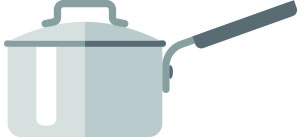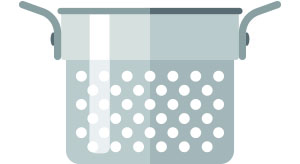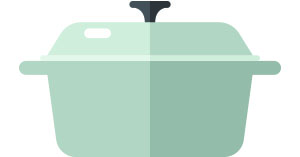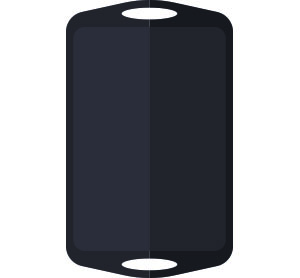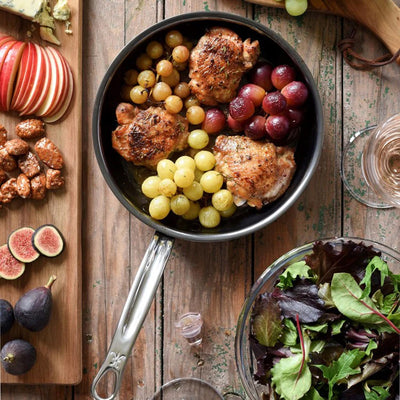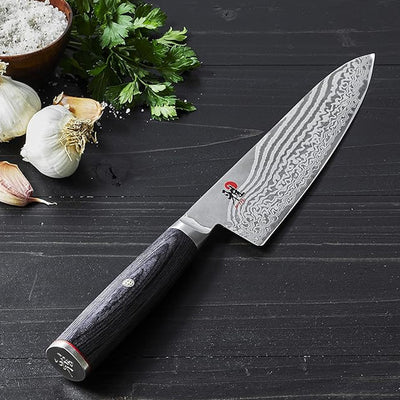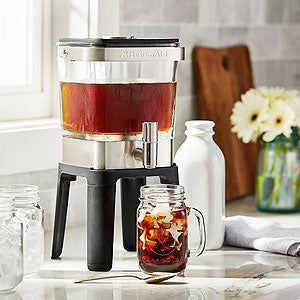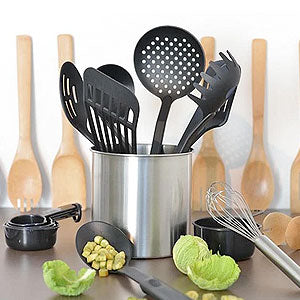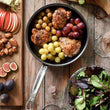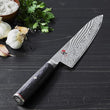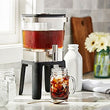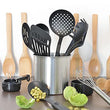Buying Guide
Cookware Buying Guide
Finding the Ideal Cookware
Whether you are buying your first set of cookware, adding to your existing pots and pans, or looking to upgrade your cookware, deciding what you need for your kitchen can be confusing. Cookware comes in a wide range of styles, designs, brands, and materials, so choosing which is right for you can seem an impossible task. Knowing if you need a saucepan, fry pan, griddle, sauté pan, Dutch oven, or roaster and made of what metal that is best for you can seem overwhelming.
With all these options in mind, how do you select the right type of cookware for your skillset and budget? This buying guide will give you the information you need to know to make an informed decision and choose cookware to best suit your needs.
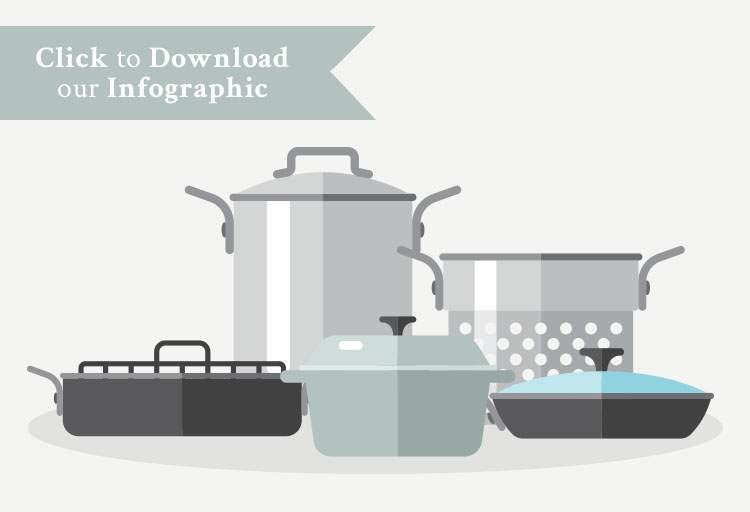
Learn how to choose cookware to suit your style, skill, and budget.
The Parts of a Pan
Handle
The handle provides a secure and comfortable grip and lets you easily pick up and hold the pan to transition it from stovetop to oven or to remove it from the burner. Handles can be made of a variety of materials and styles including metal, wood-clad, silicone-coated, and heat-resistant plastic. The best cookware offers stay-cool designs that allow you to hold them without mitts.
Rivets
Top-quality cookware use rivets to join the handle to the body. Rivets create a sturdy joint that never needs tightening though they can be harder to clean. Other fasteners such as screws or welded joints can be used. Screws make it easy to replace the handles, but will require periodic tightening. Welded joints allow for a smooth interior, but are not as sturdy as the riveted joints.
Body
The body is the main part of the pan and can be made of a variety of materials such as stainless steel, aluminum, enameled cast iron, non-enameled cast iron, or copper.
Rim
The rim or edge of the pan can either be slightly rolled, straight, or incorporate a pouring spout. Rolled rims or those with spouts make pouring liquids from the pan into a serving dish or bakeware easier. Straight edges work better for tossing or stirring ingredients.
Cooking Surface
The interior surface of the pan which includes non-stick, stainless steel, and cast iron. Each type has pros and cons based on the different foods being cooked on it. Non-stick offers easy clean-up. Stainless steel is durable and good for browning and sautéing. Cast iron is durable, stick-resistant, and can go from stovetop to oven.
Core
Many pans, especially stainless steel cookware, are constructed with multiple layers of metal which come in contact with the heat source. The core is the layer made of conductive metals such as aluminum or copper.
Base
A flat base will work best on smooth-top electric stoves. For induction ranges, bases with magnetic materials such as stainless steel respond better to the magnetic field generated by the cooktop.
Sides
The sides of the pan can be high or low, vertical or flared depending on the designated usage. High vertical sides that are found in most saucepans are ideal for simmering liquids. Flared sides which are found in many sauté and fry pans help cooking liquids reduce through evaporation.
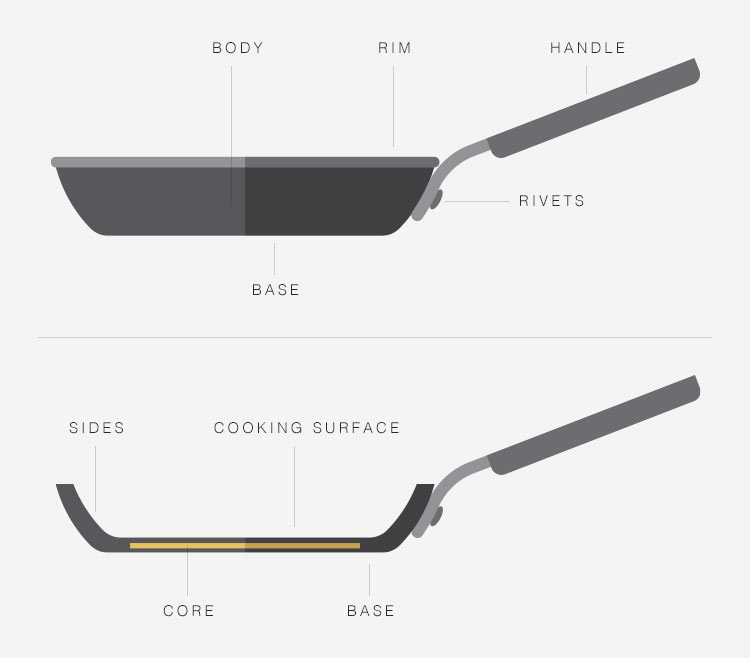
Common terms used to describe the anatomy of a cooking pan.
Common Types of Cookware and Its Uses
Saucepan
A heavy pan with a flat base and tall, vertical sides, a saucepan is the most basic cooking essential. It’s a workhorse that goes beyond sauce as it is used for soups, cooking rice, potatoes, vegetables, gravy, syrups, and more. You can use it for boiling, steaming, and reheating. It’s straight, high sides keep contents from spilling as you stir, making it perfect for liquid ingredients. Keep different sizes on hand to accommodate cooking several dishes on the stove at once or to when you need to prepare smaller or larger portions.
Fry Pan / Frying Pan
A fry pan is one pan you’ll use every day. Designed for frying and searing a variety of foods, it’s ideal for making omelets, scrambled eggs, cooking pancakes, sautéing veggies, and frying meat. Its slanted sides allow you to move ingredients around easily and quickly while its generous surface area will maximize space on your stovetop.
Sauté Pan
Similar to a fry pan, a sauté pan features a wide, flat bottom with vertical, moderately high sides, and a long stick handle. It’s used to sauté vegetables and meats and fast cooking of foods that require shaking, tossing, or stirring. Larger sizes often have a helper handle on the opposite side of the stick handle.
Stock Pot
These large lidded pots feature tall vertical sides, making them perfect for cooking batches of soups, stews, boiling larger portions of vegetables, boiling lobsters, crabs, and shellfish, or even deep frying in a pinch. You can also use a stock pot with a perforated insert to steam food above water. Like saucepans, stock pots come in a variety of quart sizes.
Pasta Cooker / Steamer
This type of pot is great to use for more than pasta, it works well for soups, stews, and boiled lobsters. The deep sided pot uses a pasta insert that lifts out to drain and a separate top basket to steam vegetables, seafood, and other foods. Some may have a perforated lid and pouring spout to make it easy to drain the water out into the sink while holding the ingredients in the pot.
Cast Iron Skillet
Every kitchen should have at least one versatile cast iron skillet in its inventory of cookware. This type of skillet holds high temperatures to sear, brown, and blacken foods. When properly seasoned with a thin layer of polymerized oil, it has a naturally stick-resistant surface and can go from stovetop to oven with ease. It adds iron to your foods and is chemical free. Cast iron is durable and will provide decades of use with a little care and maintenance. It requires handwashing and applications of vegetable or canola oil after cleaning and use to keep it seasoned and rust-free.
Wok
Woks are a popular, all-purpose Asian pan with high, sloping sides. They have a hot cooking surface on the bottom while being cooler on the sides. The sloping sides allow you to easily move ingredients around the pan with great control and versatility over the temperature. They are ideal for stir frying, steaming, and deep frying and have a long stick handle for griping and often a second helper handle for easier lifting from the stovetop.
Dutch Oven
This versatile covered pot allows you to start dishes by braising them on the stovetop, finishing them in the oven, and serving them at the table. Its all-in-one design makes it a convenient addition to your cookware that saves you extra cleanup chores. Use it to make stocks and sauces, roasted chicken, pot roast, stews, risotto, and more.
Pressure Cooker
Pressure cookers have lids that completely seal the pot while liquid is boiling inside. Pressure builds as the heated liquid creates steam, resulting in higher cooking temperatures and shorter cooking times. A safety valve will automatically vent the steam, and some models have a quick-release option to waste less time to cool food down. A detachable pressure regulator can adjust the pressure to low, medium, and high settings. Always use a timer when cooking with a pressure cooker to ensure you don’t overcook more delicate dishes or vegetables.
Roasting Pan / Roaster
A roaster is a large, rectangular pan with low sides that allow the oven’s heat to reach as much of the food as possible. It’s designed for roasting meats and poultry in the dry heat of an oven at relatively high temperatures. Roasting pans are commonly used with a roasting rack to elevate the food such as a turkey above the cooking surface and allowing the juices to drain to the bottom for use as gravy. Non-stick roasters are easier to clean, but regular cooking surfaces will make better gravy.
Grill Pan
With its ridged cooking surface, a grill pan mimics the functionality of the grates of an outdoor grill. Its low sides increase air circulation to evenly brown meat and vegetables. A grill pan is designed for high-temperature cooking such as grilling and searing. If you like to have grill marks on your food, choose a cast iron or enameled cast iron grill pan. For easier clean-up, choose one with a non-stick finish.
Griddle
A griddle is a broad, flat pan that sits flat on a stovetop over one or two burners. Griddles often have non-stick or stick-resistant surfaces and are great for cooking eggs, pancakes, grilled cheese, bacon, hamburgers, and other fast-cooking foods that cook better on a large, smooth cooking surface. Some have a depression around the rim to catch grease.
The final choice of what types of pans to purchase is a personal choice based on your budget and your methods and style of cooking. Start with a few basics including a few saucepans, a skillet, fry pan, stock pot, and sauté pan. More specialty pans such as a griddle, wok, Dutch oven, pressure cooker, and other task-specific cookware can be added as budget and need permits.


